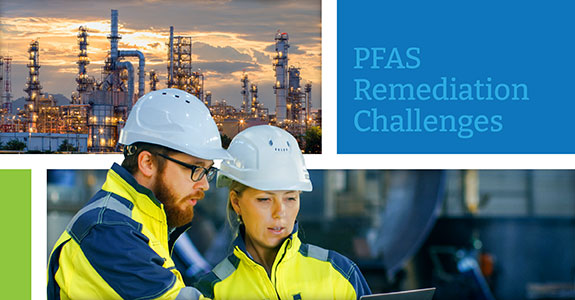
PFAS Remediation: Fundamental Challenges for the Short and Long Term
March 9, 2022
By: Steve Woodard
Part 4 of a special, four-blog series
You’ve been seeing plenty of things about PFAS regulations, analytical methods and reporting, so you have an idea of how you can address it, but if you have a problem with PFAS, now you need to remediate it. Here are some of the key issues that organizations doing this sort of remediation are seeing and experiencing, and here’s some notable things I’ve seen in some of the work we’ve been doing for our clients. I’ll be sharing some options and thoughts on where the regulations are headed, and we’ll talk about the importance of reducing PFAS waste generation. We’ll also cover how to minimize your cost of treatment.
What’s the main theme with PFAS remediation over the past year?
It comes as no surprise that with all the changes in the PFAS landscape, we’ve been learning that technology decisions are shifting to align with evolving regulations. For example, 16 states now have regulations for short-chain PFAS. We also agree that PFAS waste minimization is a growing concern due to changing PFAS waste disposal regulations and that the field of PFAS destruction is evolving and developing rapidly, constantly changing.
With all the ongoing changes, there is growing concern about lifecycle cost – the capital installation and long-term cost of removing waste and/or dealing with it, and questions about how to minimize this lifecycle cost given the changing regulations in clean up and waste minimization. We’re clearly at a crossroads, but with the proposed changes and new technologies and methodologies in PFAS remediation, there are opportunities.
What are some of the biggest concerns you’ve been hearing about PFAS remediation?
- Where are the PFAS regulations headed?
With the depth of proposed changes and new regulations, there’s never been a more important time to have a clear, detailed understanding of your PFAS picture and remediation strategy. Part of this strategy may call for the removal of short chain compounds.
- What are the options for removing PFAS?
The multitude of PFAS mitigation technologies means that you have options on how to mitigate these compounds. The question on many minds today is how do I decide which option is best for me? (ion exchange resin, granular activated carbon, membrane technology such as reverse osmosis or nano filtration, foam fractionation) these options are an important consideration and each has their own challenges and applications. Selecting the right technology involves conducting a detailed analysis, and it’s the long-term O&M costs that typically drive the lifecycle cost comparison.
- What is the future of incineration? Is it going away? And How do I minimize liability associated with PFAS waste disposal?
Some entities have begun to discuss the end of incineration as a disposal method. While this is still on the radar, now is the time to evaluate other options for disposal or destruction. And careful consideration of your disposal/destruction options can contribute greatly to potential liability concerns.
Remediation is a complex part of your PFAS plan, but you don’t need to go it alone.
I’m looking forward to our PFAS focused webinar, the 2022 PFAS Crystal Ball, March 10, 2022 @ 2 PM EST, where as a panelist, I’ll be elaborating on these topics alongside some other experts from the Montrose family. Join us to learn more about remediation, regulations and what’s coming up in the PFAS landscape – what you need to know, and where you can find answers to your questions.
The 2022 PFAS Crystal Ball: What’s Coming, and How You Can Be Ready
A Blog Series and an Informative Webinar
- Part 1: PFAS Regulatory Developments: Concerns, Employee Safety and Community Impact:
What You Need to Know to Stay Ahead of The Curve - Part 2: Current and Future Requirements in PFAS Compliance, Assessment and Remediation:
What You Need to Know and Why - Part 3: PFAS: Regulatory Constraints from Both an Analytical Methodology and Regulatory Perspective
- Part 4: PFAS Remediation: Fundamental Challenges for the Short and Long Term
 Steven Woodard, Ph.D., P.E., – Chief Innovation Officer, ECT2 Panelist
Steven Woodard, Ph.D., P.E., – Chief Innovation Officer, ECT2 Panelist
Steve Woodard, Ph.D., P.E., brings over 33 years of experience in water and wastewater treatment to the ECT2 team where he currently leads as Chief Innovation Officer. Currently focused on commercializing synthetic media technology targeting PFAS, 1,4-dioxane, specialty VOCs, and other emerging contaminants, his responsibilities include leading research and new product development, providing technical leadership on all projects, proposal development, intellectual property, and communication with the engineering and remediation communities. Due to his subject matter expertise and industry development success, Steve has delivered many presentations and participated in expert panel discussions across the globe. Steve holds ten patents for technology developed in the implementation of various systems and methods for treating water, wastewater, groundwater and vapor. He has also authored multiple publications including journal articles and textbook chapters related to his industry knowledge and expertise. Steve holds a Ph.D. in Environmental Engineering from Purdue University.

